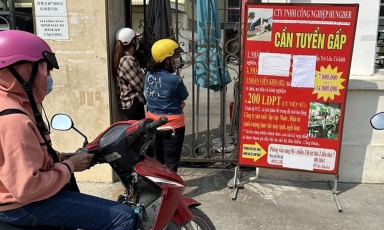Harnessing the digital revolution to build safer, healthier workplaces
To mark International Day for Safety and Health at Work, Kaori Nakamura-Osaka, International Labour Organization Assistant Director General and Regional Director for Asia and the Pacific explains how an inclusive approach to digitalization can help transform workplace safety and health.

Digital technologies, from artificial intelligence (AI) and robotics to wearable sensors and virtual reality, are revolutionizing workplaces. They hold huge potential to reduce occupational health and safety risks and improve working conditions. But they also bring new hazards, inequalities and regulatory gaps that we must urgently address.
In sectors across Asia and the Pacific the digital transition is gaining momentum. Automation is reducing worker exposure to chemicals, noise, dust, extreme temperatures and dangerous machinery.
In New Zealand, robotics networks are exploring how automation can reshape workplace safety across industries. Malaysia, meanwhile, is integrating AI-driven safety protocols in sectors such as electronics, where production lines involve repetitive tasks and exposure to physical and chemical hazards.
Prevention underpins workplace health and safety. Smart monitoring systems and predictive analytics are giving employers and workers the tools to detect hazards before they escalate. Virtual reality and extended reality are transforming how we train workers, especially in high-risk sectors. Immersive simulations allow workers to rehearse emergency responses or navigate hazardous environments without danger. Algorithmic management, using AI to assign, monitor and evaluate tasks, can also play a role.
Yet if not properly managed, these systems can also intensify work, erode autonomy and amplify surveillance, increasing stress and diminishing well-being. While digitalization has helped drive a huge uptick in remote and platform work across the region it also blurs the boundaries between work and rest. Adverse health outcomes range from musculoskeletal strain to burnout and digital isolation. Drivers rush to deliver goods or pick up passengers, putting themselves and their clients at risk. Workers in the gig sectors often lack basic OSH protections. Many digital labour platforms also provide no structured support for physical and mental health, despite growing health and safety risks due to psychosocial, ergonomics and environmental hazards.
To navigate these complex dynamics, governments, employers and workers must collaborate to shape a future where digitalization enhances, rather than undermines, worker safety and dignity. The International Labour Organization (ILO)’s fundamental Conventions, including Convention No. 155 on Occupational Safety and Health and Convention No. 187 on the Promotional Framework, provide a robust framework to support this effort.
Regulatory frameworks need to evolve and legal systems around the region are beginning to respond.
For example, in Singapore, since 1 January 2025 the Work Injury Compensation Act includes platform workers like drivers and delivery personnel, providing them with social protection similar to traditional employees. Meanwhile in Japan, efforts are underway to expand the coverage of OSH legislation to individuals running their own business, such as platform workers without employment contracts.
So, what steps must we take next?
First, OSH must be embedded in all digital transformation strategies, from AI and robotics to data governance. Second, OSH laws need to be regularly updated to address emerging risks, such as algorithmic bias, mental health impacts and the right to disconnect. Third, inclusive and continuous training is essential to ensure that all workers, not just those in high-tech industries, can use digital tools safely. Special attention must be paid to vulnerable groups, including women, youth, older workers and persons with disabilities.
We must also ensure both worker and employer participation at every stage of the technological journey, from the design of new regulations, policies and tools to their implementation and review.
Finally, digital innovation should support, not replace, human oversight. Smart sensors, predictive analytics and automated decision-making systems are invaluable, but they must be integrated into robust OSH frameworks guided by human judgement, ethical standards and worker rights.
Digitalization is not just about efficiency. It is a once-in-a-generation opportunity to create safer, healthier and more resilient workplaces. But we must be intentional. We must be inclusive. And above all, we must ensure that no one is left behind in the race toward the future of work.
On this World Day for Safety and Health at Work, let us commit to a future where innovation and protection go hand in hand. A future where every digital advance is a step forward for human dignity, health and safety./.
Kaori Nakamura-Osaka, ILO Assistant Director General and Regional Director for Asia and the Pacific
TAG:
healthier workplaces












